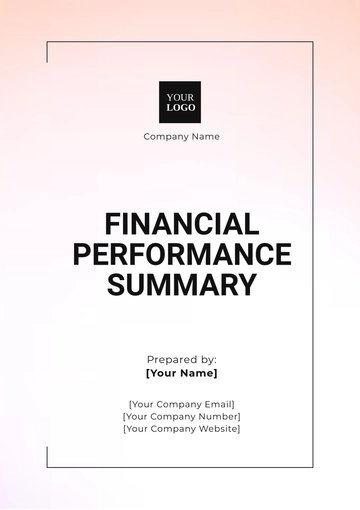Free Auction Performance Report

1. Introduction
The Auction Performance Report is an essential tool for evaluating the effectiveness of auction strategies and operations. It provides an in-depth analysis of the auction events conducted by [Your Company Name] throughout the year 2050, including a detailed examination of revenue generation, bidder behavior, auction types, and trends. The purpose of this report is to offer insights that can help shape future auction strategies and improve overall performance, contributing to better outcomes in the years to come.
In 2050, [Your Company Name] hosted a variety of auction formats, from traditional live auctions to innovative online and hybrid auctions. This report aims to analyze the performance of these auctions, assess the financial results, and highlight key trends that could affect future auctions. The analysis includes both qualitative and quantitative data to ensure a holistic understanding of the company's auction performance.
2. Auction Overview
2.1. Types of Auctions Conducted
In 2050, [Your Company Name] participated in and hosted a wide array of auction types to meet the diverse needs of clients and buyers. These auction formats included traditional live auctions, online auctions, and hybrid auctions, each designed to maximize bidding opportunities and appeal to various buyer segments. Here is a breakdown of the auction types:
Traditional Live Auctions: These were held in person, often at prestigious venues such as galleries, luxury event spaces, or auction houses. Items such as fine art, rare collectibles, vintage automobiles, and high-end jewelry were commonly sold in live auctions.
Online Auctions: As the most popular auction format in 2050, online auctions allowed participants to bid from the comfort of their homes, regardless of their location. These auctions were widely used for selling a range of products, including real estate, industrial machinery, electronics, and antiques.
Hybrid Auctions: A blend of both online and in-person auctions, hybrid auctions enabled bidders to attend physically while others participated remotely. This format gained popularity as it offered more flexibility and attracted a wider range of buyers.
2.2. Auction Formats
Each auction format employed a specific approach to maximize bidding engagement and optimize outcomes for both buyers and sellers. Here are the key formats used:
Reserve Price Auctions: These auctions started with a minimum price set by the seller, and bidding began from that amount. If the bids did not meet or exceed the reserve price, the item would not be sold.
No-Reserve Price Auctions: These auctions started without a predetermined minimum price, offering a chance for items to be sold at a lower price if competition was weak. This format is often used to quickly sell large quantities of items.
Timed Auctions: This format imposed a time limit on bidding, creating a sense of urgency among bidders. Timed auctions were commonly used in online settings for items that had a limited appeal or required fast liquidation.
Silent Auctions: In these auctions, bids were placed anonymously without any visible competition. Silent auctions were typically used in fundraising events and were prevalent in charity auctions where the goal was to raise funds rather than achieve the highest possible sale price.
2.3. Key Auction Metrics
The success of each auction type and the overall performance of [Your Company Name] in 2050 was measured through several key performance indicators (KPIs). The most important KPIs included:
Total Revenue Generated: The total amount earned from the sales of auctioned items. This is a critical metric to assess the financial success of the auctions.
Bidder Participation: This indicates the number of registered bidders who participated in each auction.
Average Bid Value: The average value of the bids placed during the auction, reflecting the overall quality of items sold.
Item Sell-Through Rate: The percentage of items that were successfully sold during the auction relative to the total items listed.
Auction Success Rate: The percentage of auctions that reached or exceeded their financial goals.
3. Auction Performance Analysis
3.1. Total Revenue Generated
The total revenue generated by [Your Company Name] through auctions in 2050 reached an impressive [$25,000,000]. This total represents a [12%] increase over the previous year’s revenue of [$22,500,000], showcasing the company’s growth and the increasing popularity of its auction formats.
The breakdown of revenue by auction type is provided below:
Auction Type | Revenue Generated | Percentage of Total Revenue |
|---|---|---|
Traditional Live Auctions | $7,500,000 | 30% |
Online Auctions | $15,000,000 | 60% |
Hybrid Auctions | $2,500,000 | 10% |
Total | $25,000,000 | 100% |
The online auctions generated the largest portion of the total revenue, accounting for [60%] of the total amount. This shift toward online bidding aligns with global trends in digitalization, where convenience, accessibility, and a broader reach have become key drivers for buyers and sellers alike.
3.2. Bidder Participation
Bidder participation increased substantially in 2050, with [50,000] unique registered bidders across all auctions, a [8%] increase compared to the previous year. Of the total bidders, the online auctions attracted the largest number of participants, with [35,000] registered bidders, while traditional live auctions saw [12,000] participants, and hybrid auctions attracted [3,000] bidders.
Auction Type | Bidders Registered | Percentage of Total Bidders (%) |
|---|---|---|
Traditional Live Auctions | $12,000 | 24% |
Online Auctions | $35,000 | 70% |
Hybrid Auctions | $3,000 | 6% |
Total | $50,000 | 100% |
The rise in bidder participation in online auctions mirrors the convenience and accessibility these platforms offer. Online auctions continue to attract a wide range of bidders, particularly from geographically diverse regions, ensuring greater competition and higher sale prices.
3.3. Item Sell-Through Rate
The item sell-through rate is a critical metric for measuring the success of each auction. A higher sell-through rate indicates that the auction was successful in attracting buyers and matching items with bidders. In 2050, the overall sell-through rate across all auction formats was [85%]. This is a strong performance, with a notable difference between auction types.
Auction Type | Items Listed | Items Sold | Sell-Through Rate (%) |
|---|---|---|---|
Traditional Live Auctions | 1,200 | 1,100 | 92% |
Online Auctions | 3,000 | 2,400 | 80% |
Hybrid Auctions | 500 | 450 | 90% |
Total | 4,700 | 3,950 | 85% |
Traditional live auctions had the highest sell-through rate, at [92%], indicating that the items offered were highly desirable and attracted competitive bids. The lower sell-through rate for online auctions, at [80%], can be attributed to a wider variety of items being auctioned, with some items attracting less interest or not meeting the reserve price.
3.4. Average Bid Value
The average bid value provides insight into the overall quality and desirability of auctioned items. In 2050, the average bid value across all auctions was approximately [$5,000]. However, the value varied significantly depending on the auction format.
Auction Type | Average Bid Value ($) |
|---|---|
Traditional Live Auctions | $10,000 |
Online Auctions | $2,000 |
Hybrid Auctions | $5,500 |
Total | $5,000 |
The average bid value for traditional live auctions was the highest at [$10,000], which can be attributed to the premium nature of the items sold, including fine art, luxury goods, and rare collectibles. Online auctions had a lower average bid value of [$2,000], reflecting a broader range of product categories, some of which were lower in value. Hybrid auctions, with an average bid value of [$5,500], balanced between high-value and more affordable items.
4. Buyer and Seller Behavior Analysis
4.1. Buyer Behavior Trends
Buyer behavior is a crucial component of auction performance. Understanding how buyers engage with auctions, including their preferences and motivations, helps to optimize the auction process. Some key trends observed in 2050 include:
Increasing Shift to Online Bidding: More buyers are opting to participate in online auctions due to the convenience and global access these platforms provide. Online auctions for industrial equipment and real estate, for example, attracted large numbers of bidders from across the world.
Use of Proxy Bidding: Many buyers are increasingly utilizing proxy bidding, especially in online auctions. Proxy bidding allows bidders to set a maximum price, and the system automatically bids for them up to that amount. In 2050, approximately [40%] of all online bids were placed through proxy bidding.
Global Buyer Reach: Online auctions have enabled bidders from different countries and regions to participate. This global reach has expanded the market for products like rare antiques, vintage cars, and fine art, which can now attract international interest.
4.2. Seller Behavior Trends
Seller behavior also provides valuable insights into auction performance. Sellers are becoming more strategic in choosing the right auction format and platform to achieve the best results. Some trends observed in 2050 include:
Preference for Online Auctions: More sellers are turning to online auctions due to the broader reach and ease of use. Online platforms allow sellers to connect with a global pool of buyers, increasing the likelihood of a successful sale. This trend has been especially evident in industries like real estate and automobiles.
Hybrid Auction Demand: Many sellers are choosing hybrid auctions to take advantage of both in-person and online bidding opportunities. This format offers flexibility and appeals to a wider range of buyers, as it accommodates both those who prefer a traditional auction environment and those who prefer the convenience of online bidding.
Seller’s Reserve Prices: The use of reserve prices has become increasingly common among sellers. In fact, in [60%] of all auctions, sellers set reserve prices to ensure that their items were sold for at least a minimum acceptable price. This is particularly true for high-value items such as fine art and luxury goods.
5. Future Trends
5.1. Increasing Use of Artificial Intelligence (AI)
AI is expected to play an increasingly significant role in the auction industry in the coming years. In particular, AI-driven tools for predicting bid behavior, optimizing pricing strategies, and enhancing fraud detection will become essential for auction platforms. For example, AI algorithms can analyze bidding patterns to predict which items are likely to attract higher bids, allowing auctioneers to adjust their strategy accordingly.
5.2. Enhanced Virtual Reality (VR) Experiences
Virtual reality (VR) technology has the potential to revolutionize online auctions, particularly in sectors like art and collectibles. By allowing bidders to virtually inspect items in 3D, VR can replicate the in-person experience for online participants, increasing engagement and trust. This will be particularly beneficial for high-value items where buyers may be hesitant to purchase without seeing them firsthand.
5.3. Blockchain for Auction Transparency
Blockchain technology is poised to improve transparency and security in auctions. By recording every transaction on a decentralized ledger, blockchain can verify the authenticity and ownership of items being auctioned, making the process more secure and reliable. This will be especially important for high-value items like artwork, antiques, and luxury goods, where provenance and authentication are critical.
6. Strategic Insights and Recommendations
6.1. Optimizing Auction Formats
As the auction landscape evolves, it's crucial to continually adapt to the preferences of buyers and sellers. The growing preference for online and hybrid auctions suggests that [Your Company Name] should further invest in enhancing these formats. Key recommendations for optimizing auction formats in the future include:
Expand Hybrid Auction Offerings: Hybrid auctions are likely to remain a popular format as they provide flexibility and attract both traditional and online bidders. Increasing the number of hybrid events, especially for high-value items, will cater to a broader audience and maximize revenue potential. This would include offering real-time streaming for in-person events and ensuring robust digital platforms that support seamless online participation.
Increase Auction Accessibility: Enhancing accessibility through mobile apps and user-friendly interfaces will ensure that bidders can engage more easily, regardless of their location or time zone. Providing a more intuitive and engaging bidding experience can help to attract and retain participants, especially in international markets.
Tailored Auction Formats for Specific Industries: As auction types continue to diversify, [Your Company Name] should consider creating industry-specific auctions that cater to the unique needs of various sectors. For instance, creating niche auctions for technology products, luxury goods, or fine art can target specific groups of buyers and maximize engagement in those categories.
6.2. Enhancing Bidder Engagement
Building and maintaining bidder engagement is essential to maintaining a healthy auction environment. The following strategies can be implemented to improve bidder retention and engagement:
Incentivize Repeat Bidders: Offering loyalty programs, such as discounts or exclusive access to premium auctions, can encourage repeat participation. This type of program can reward high-frequency bidders and create a sense of community within the auction environment.
Personalized Bidding Experiences: By utilizing data analytics and AI, personalized recommendations can be made to bidders based on their previous purchases or browsing behaviors. This level of customization will create a more personalized experience, potentially increasing bidder satisfaction and driving higher bids for desirable items.
Interactive Features for Online Auctions: Adding interactive features such as live chats, real-time bidding competitions, and virtual showrooms can make online auctions more engaging. This also gives bidders the chance to connect with auctioneers, ask questions about the items, and interact with other participants, adding a layer of social engagement to the process.
6.3. Data-Driven Decision Making
Leveraging data analytics will be crucial in the coming years for refining auction strategies and optimizing outcomes. Some steps for incorporating data-driven decision-making include:
Bidding Behavior Analysis: By analyzing bidding patterns and identifying trends, [Your Company Name] can better predict the success of future auctions and adjust strategies accordingly. For example, understanding the bidding dynamics in real-time can help auctioneers better manage the pace of bidding, ensuring that they do not push bids too early or too late in the process.
Buyer Demographics and Preferences: Gaining deeper insights into the demographics and preferences of auction participants can inform marketing and sales strategies. By understanding the buyer’s interests, auction organizers can better curate inventory, target specific audience segments, and maximize engagement for each event.
Price Prediction Models: Implementing machine learning algorithms to predict the likely final bid price for an item based on factors such as historical bid data, the item’s rarity, and the bidding activity can help sellers set more accurate reserve prices. This will reduce the occurrence of unsold items and increase the success rate of each auction.
6.4. Strengthening Seller Relationships
Fostering strong relationships with sellers is essential to ensure a steady flow of high-quality items in future auctions. The following strategies are recommended for building and maintaining these relationships:
Seller Education and Consultation: Offering consultation services to sellers can help them better understand the auction process, set realistic expectations, and increase their chances of a successful sale. Educational workshops and one-on-one meetings can also address concerns about pricing, reserve prices, and timing.
Streamlined Onboarding Processes: Simplifying the onboarding process for new sellers, including an easy-to-use interface for listing items, will make it more appealing for them to participate in [Your Company Name]'s auctions. Providing sellers with a dedicated representative can further personalize the experience and improve satisfaction.
Dedicated Seller Portals: Developing dedicated seller portals where they can track auction results, view real-time data on bidding progress, and access reports will enhance transparency and improve relationships with sellers. The ability to provide immediate feedback on auctions can also foster loyalty and trust.
6.5. Enhancing Transparency and Trust
Transparency and trust are paramount in the auction industry. Buyers and sellers need confidence in the platform to engage in high-value transactions. The following recommendations aim to build a more trustworthy environment for auction participants:
Implement Blockchain for Provenance Verification: Blockchain technology can be used to ensure that each item sold in the auction has a verifiable provenance. This can be particularly important for high-value goods like artwork, luxury items, and antiques, where authenticity is crucial. By using blockchain to record every transaction, [Your Company Name] can offer a level of transparency that sets it apart from competitors.
Enhanced Seller and Item Verification: Tightening seller and item verification processes will reduce the risk of fraud and ensure that only legitimate goods are sold at auction. Sellers should be required to submit documentation proving the authenticity of the items they are listing. This can include certificates of authenticity, appraisals, or third-party verification services.
Secure Payment Systems: Offering a secure, encrypted payment platform for both buyers and sellers will minimize the risks of fraud and build confidence in the auction process. Ensuring that funds are safely handled, and providing multiple payment options (including digital wallets and cryptocurrency) will make the auction process smoother for all parties involved.
6.6. Exploring International Expansion
Given the global nature of the auction market in 2050, expanding into new geographic markets can present significant growth opportunities. To achieve this, [Your Company Name] could consider the following:
Targeting Emerging Markets: Many emerging markets in Asia, Africa, and Latin America are becoming increasingly affluent, and these regions represent untapped potential for high-end auctions. By adapting the auction model to cater to local preferences and using language localization, [Your Company Name] can tap into these growing markets.
Offering International Shipping and Logistics: To cater to a global buyer base, offering seamless international shipping and logistics solutions will be essential. This includes providing transparent pricing for international buyers and ensuring that items are delivered securely and on time.
Establishing Partnerships with Local Influencers: Partnering with local influencers or auction houses in key international markets can help increase visibility and trust among local buyers. These collaborations can also provide valuable market insights to adapt the auction offerings to the preferences and behaviors of the local audience.
7. Conclusion
2050 has been a year of strong growth and adaptation for [Your Company Name]. The performance metrics, including revenue generation, bidder participation, sell-through rates, and average bid values, show a positive upward trajectory, particularly with the increasing prominence of online and hybrid auctions. The trends suggest that digitalization will continue to shape the auction industry, making it increasingly important for companies to adopt innovative technologies and strategies to stay competitive.
Key strategies moving forward include expanding hybrid auctions, engaging bidders through interactive features, leveraging AI and data analytics, and enhancing transparency through blockchain technology. Additionally, strengthening relationships with sellers and buyers alike and exploring new international markets will be critical for sustaining growth in the years ahead.
- 100% Customizable, free editor
- Access 1 Million+ Templates, photo’s & graphics
- Download or share as a template
- Click and replace photos, graphics, text, backgrounds
- Resize, crop, AI write & more
- Access advanced editor
Track and evaluate auction results with the Auction Performance Report Template from Template.net. This editable and customizable template helps you analyze key performance metrics. Tailor it to your needs using the AI Editor Tool.
You may also like
- Sales Report
- Daily Report
- Project Report
- Business Report
- Weekly Report
- Incident Report
- Annual Report
- Report Layout
- Report Design
- Progress Report
- Marketing Report
- Company Report
- Monthly Report
- Audit Report
- Status Report
- School Report
- Reports Hr
- Management Report
- Project Status Report
- Handover Report
- Health And Safety Report
- Restaurant Report
- Construction Report
- Research Report
- Evaluation Report
- Investigation Report
- Employee Report
- Advertising Report
- Weekly Status Report
- Project Management Report
- Finance Report
- Service Report
- Technical Report
- Meeting Report
- Quarterly Report
- Inspection Report
- Medical Report
- Test Report
- Summary Report
- Inventory Report
- Valuation Report
- Operations Report
- Payroll Report
- Training Report
- Job Report
- Case Report
- Performance Report
- Board Report
- Internal Audit Report
- Student Report
- Monthly Management Report
- Small Business Report
- Accident Report
- Call Center Report
- Activity Report
- IT and Software Report
- Internship Report
- Visit Report
- Product Report
- Book Report
- Property Report
- Recruitment Report
- University Report
- Event Report
- SEO Report
- Conference Report
- Narrative Report
- Nursing Home Report
- Preschool Report
- Call Report
- Customer Report
- Employee Incident Report
- Accomplishment Report
- Social Media Report
- Work From Home Report
- Security Report
- Damage Report
- Quality Report
- Internal Report
- Nurse Report
- Real Estate Report
- Hotel Report
- Equipment Report
- Credit Report
- Field Report
- Non Profit Report
- Maintenance Report
- News Report
- Survey Report
- Executive Report
- Law Firm Report
- Advertising Agency Report
- Interior Design Report
- Travel Agency Report
- Stock Report
- Salon Report
- Bug Report
- Workplace Report
- Action Report
- Investor Report
- Cleaning Services Report
- Consulting Report
- Freelancer Report
- Site Visit Report
- Trip Report
- Classroom Observation Report
- Vehicle Report
- Final Report
- Software Report





























